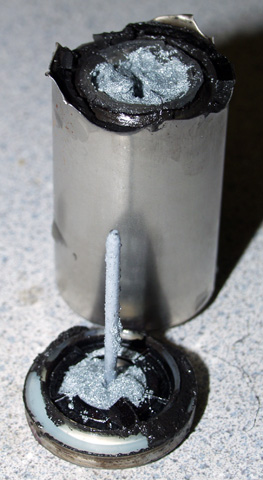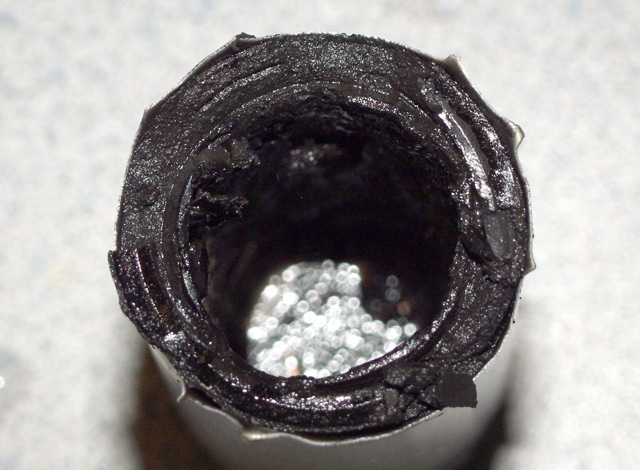Alkaline Battery Dissection
By: Spatula Tzar

Alkaline Battery DissectionBy: Spatula Tzar |  |
Welcome students, to my class on dissecting alkaline batteries. Today we will learn how to safely open a D cell, and remove its sweet, sweet chemical innards. D cells are favorable as their large size facilitates investigation, and they contain the greatest magnitude of useable chemicals.
 |
Here we see a typical D cell, already stripped of its outer plastic insulation. You needn't waste money on fresh batteries; partially used cells will work fine, as long as they still contain some charge. Around one volt is optimal. It contains a basic potassium hydroxide solution (KOH), so be sure to wear protective equipment. |
 |
We will make our primary incision in the lip of the casing, where the two poles meet. Using a side cutters, grip and tear the seam open. Watch out! The cell may be pressurized with hydrogen gas. This one leaked a small quantity of electrolyte, as you can see in the third quadrant. Luckily I was wearing gloves at the time. |
 |
Continue tearing the seam, until the cathode is free. At this point it would be a good idea to rinse off any spilled electrolyte. It forms a purple solution, as seen on the cathode. |
 |
Pull out the cathode. The end cap is attached to a brass rod, forming the negative electrode. Scrape and rinse the brass electrode clean, saving the blue paste. |
 |
Here we see the interior of the electrochemical device. Going outward radially, we have the blue zinc anode with potassium hydroxide electrolyte, a semipermeable membrane, and the black manganese dioxide (MnO2) cathode. |
 |
Scoop out the zinc paste, setting it aside. We now have a clear view of the membrane. It is comprised of two identical rectangles, pressed against the sides to form a circle. Remove them with a forceps and discard. |
 |
With the manganese dioxide exposed, begin to scoop it away. If the consistency is too solid, crimp the casing with a pliers to loosen. Set the anode material aside. |
 |
After much bending, cutting, and tearing away at the endcap, we have isolated the brass electrode. It looks very much like a nail. I think I'll use it as one. |
 |
These are the cathode and anode materials, respectively. Don't be fooled by the volume of the manganese dioxide. It is filled with airspace. The yields are 31.0 grams for the zinc solution, and 70.7 grams for the MnO2. |
The zinc powder can be isolated from the paste by treating it with warm solvents such as acetone. It may take a while, but eventually gelatinous particles will float to the surface, where they can be removed. The pure zinc powder will collect at the bottom.
The manganese dioxide can be used to catalyze various reactions, such as the decomposition of hydrogen peroxide or potassium chlorate.
Now, go and play with your new chemicals. Class dismissed.
Bitcoin: 1KEWmWK3Sn9ToEHxhXmoXax6ycNGgLMfLv